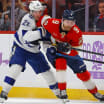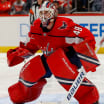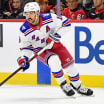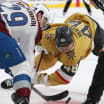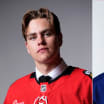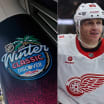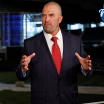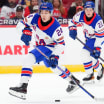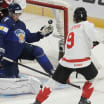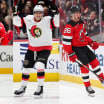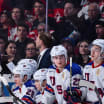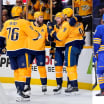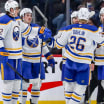The Coaches Room is a weekly column by one of four former NHL coaches and assistants who will turn their critical gaze to the game and explain it through the lens of a teacher. Jim Corsi, David Marcoux, Paul MacLean and Joe Mullen will take turns providing insight.
In this edition, Marcoux, former goalie coach for the Carolina Hurricanes and the Calgary Flames, takes us through the ins and outs of building goaltending depth, an area that's undergoing a lot of changes with NHL teams.
NHL teams putting resources toward goalie depth, development
Marcoux stresses importance of capable backups
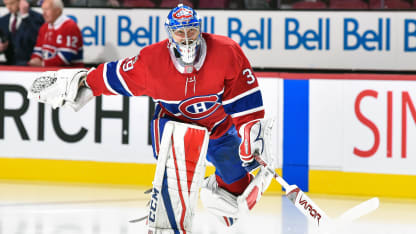
© Minas Panagiotakis/Getty Images
By
David Marcoux / Special to NHL.com
Seeing
Charlie Lindgren
get his second NHL shutout for the Montreal Canadiens, even though he lost 1-0 in a shootout to the Philadelphia Flyers on Monday, and wondering how much the Chicago Blackhawks have missed injured No. 1 goalie Corey Crawford got me thinking.
How do teams build homegrown goalie depth?
Or better, how should they?
I wrote earlier this season on how important it was for NHL teams to have a capable third goalie on their depth chart.
But goalie depth and development goes way beyond that. Every NHL team has good intentions of building for the future, but it takes more effort and planning than just the swipe-left, or who's-the-next-guy-up mentality of today.
You can be sure general managers are pondering this subject today. When Crawford, Matt Murray of the Pittsburgh Penguins, Carey Price of the Canadiens, Cory Schneider of the New Jersey Devils and Mike Smith of the Calgary Flames, to name just a few, are on the injured list this late in a season, the question of who's next has to be more important than just a list.
I've lived and worked through an NHL era where many coaches and general managers believed that backup goalies were a dime a dozen, that their No. 1 goalie could play 70-plus games and it didn't matter who the backup was.
It's not a healthy or productive approach for a team's most important position.
The Blackhawks deserve a lot of credit for their patience in Crawford's case. Crawford, who has been out since Dec. 23, was selected by Chicago in the second round (No. 52) in the 2003 NHL Draft and played five full seasons in the American Hockey League before getting his chance as a No. 1 goalie in the NHL in the 2010-11 season. Chicago showed a lot of faith in Crawford and stuck to the plan.
In terms of environment, one team that's catching my eye is the Los Angeles Kings. When Jack Campbell got his first NHL win, 4-1 against the Vegas Golden Knights on Tuesday, I think it illustrated how the Kings are doing it right.
Campbell was selected by the Dallas Stars with the No. 11 pick in the 2010 NHL Draft and was traded to the Kings on June 25, 2016. No doubt their scouting reports identified something in Campbell, where many others may have just seen a first-round pick on a treadmill. I think it's showing a program and a situation with the Kings that has blossomed with goalie coach Bill Ranford.
Ranford has Dusty Imoo working with him in goaltender development and to me they're instrumental in building a program that has allowed Campbell to mature.
Campbell, recalled from Ontario of the AHL on Feb. 22, one day after Los Angeles traded Darcy Kuemper to the Arizona Coyotes, was ready for that game Tuesday and those points are huge for the organization. It was an endorsement of how the Kings are implementing a philosophy and a program that's letting them develop, find and scout goalies properly.
I'm not certain it's all gone from the NHL but I think we're past the dysfunctional days when scouts simply looked for aggressive, poke-checking, two-pad-stacking goalies.
Many teams understand this, some to the point where budget is not the overriding concern.
The Canadiens, who identified Lindgren and brought him along as an undrafted player, employ three goalie coaches or consultants in their organization: Stephane Waite, Vincent Riendeau and Marco Marciano.
The Toronto Maple Leafs have four goalie coaches or consultants: Steve Briere, Piero Greco, Jacques Caron and Brian Daccord.
There's a right way to building a program that will give you true depth, and a wrong way. And the right way is to have goalie-knowledgeable people in your organization, people who understand the position and are committed to building relationships with younger and prospect goalies, who can assemble data, who can provide supervision and sometimes read the riot act to young goalies.
These are big decisions, trying to decide which prospects to sign. And as big, I'd suggest, trying to decide which goalie prospects to draft. It's not just a lottery, and most teams aren't treating it as one in today's game.
It begins with amateur scouting, having scouts who are goalie-knowledgeable. And it continues with player development people who have an understanding of the position because after the draft it's a critical time when you have two years for a junior goalie or four years for a college goalie to decide whether you should sign them.
Either before or after the draft, the easiest thing to do is to look at the statistics and see which have the best numbers. I've watched a lot of junior hockey this season -- my son Adam is a goalie playing in the British Columbia Hockey League -- and I know that a goalie with a 1.90 goals-against average is not necessarily the best one in a particular league. There are good goalies that are protected by great teams or defensive systems, allowing them to look outstanding statistically.
Mining the data is important but the data has to include more than score sheets. It has to include reports from more than one or two games from goalie-knowledgeable scouts and coaches.
Here's another NHL example. The Flyers have 12 goalies in their organization. They're on the high side, but they have Kim Dillabaugh as their goalie coach, somebody who has worked in the minors and has done the milk runs finding and scouting goalies for the Kings. And they have Brady Robinson on their staff, too.
Philadelphia's general manager is Ron Hextall, a former goalie who understands the importance of this area.
The implementation of a healthy program goes right to the grassroots.
Having people on the same page is essential. In a perfect world, you'd have a director of goaltending in upper management who would oversee and coordinate all levels of goalie scouting and development. Your NHL goalie coach needs to be around NHL goalies 90 percent of the time. Your AHL goalie coach should develop youth but also act as a pro scout. Finally, a junior goalie coach should also scout world-wide and support signed goalies still in junior or college.
Prospect goalies need to feel the love too. I think it's imperative for teams to build those relationships and to establish that networking. It benefits everybody. Frequently taking a weekend to pay attention to a prospect can pay big dividends. That's hard to do when you have only one goalie coach in the organization.
Taking the time to understand young goalies is crucial. Everyone's seeking knowledge. Understanding that mistakes are part of the process is central to the equation.
I've done interviews with young goalies prior to drafts. Many try to hide their weaknesses, but knowledgeable coaches and scouts see right through that. You're looking for a young goalie who is confident enough to expose himself, to say that there are elements in his game that he knows he needs to work on. Some young goalies don't understand that it's OK to not be perfect, that goalies peak at about age 27 and that they may be 10 years away.
A young goalie gains a lot of credibility if he's able to say he's not perfect. That kind of maturity is priceless. Goalies who don't have that are harder to work with because they're in denial. You're looking for good candidates who aren't looking for a quick road to the NHL but someone who is in it for the long haul, to do the everyday things that will carry you through when tough times arrive.
If the right organizational system is in place, with people who understand those kinds of priorities and how to talk to developing goalies, the sky is the limit for a future payoff in goaltending depth.
